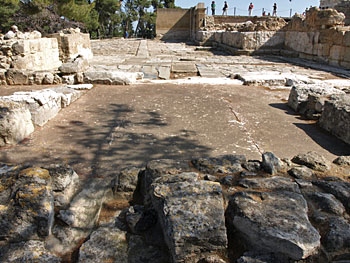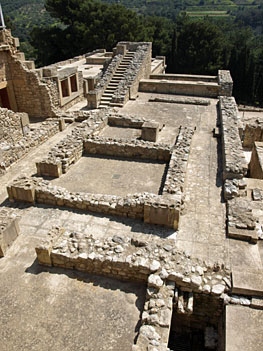The contribution of Arthur Evans
On Friday 23 March 1900 at 11 a.m. Arthur Evans began his excavation of Knossos. Although he was not the first to excavate at the site, that honour belongs to a Greek appropriately called Minos Kalokairinos in 1878, it was to be Evans who uncovered the Knossos Palace and brought to light a hitherto unknown civilisation -- possibly the oldest in Europe. The basic excavation of the site took four years and for the rest of his life Evans continued working on the site, reconstructing and building, often in an attempt to preserve the remains from the weather to which they had been exposed for the first time in 3,500 years.
Evans designated the building at Knossos a palace and named the civilisation that had built it the Minoans, after King Minos of Greek mythology. Since then the actual function of the building and of the other palaces has been questioned and new interpretations advanced. Alternative views consider the four large palaces of Minoan Crete to be temples or administrative centres or both, and in one interpretation, Knossos is seen as a necropolis -- a huge burial site to which only a small band of priests and embalmers had access. The latest theory is that the palace was not inhabited by the rulers of Knossos but was used as a place of ceremony. Here, following convention, the name Palace is used throughout.
Evans, like all of us, was a product of his time, and his time was Victorian England. He was an amateur archaeologist as were many archaeologists at the time. Only wealthy men of leisure could afford to carry out the kind of archaeological dig that Evans carried out at Knossos and professional archaeologists received even less government support then than they do now. We are fortunate that Evans was a rather better archaeologist than many of his generation, thanks in part to his father, himself an amateur archaeologist. No less important, he had the support of an excellent team of British archaeologists including Theodore Fyfe and Duncan Mackenzie as well as talented Greeks including the Cypriot Gregorios Antoniou and the Cretan Emmanouel Akoumianakis, known as Manolaki, who much later was killed fighting the Germans in the Battle of Crete.
It could have been worse
Mackenzie, in particular, was to play a crucial role in the excavations as he kept daybooks in which he recorded all the developments at the excavation site. He probably had the most scientific approach of any archaeologist working in the Aegean at that time. Sadly he later suffered from severe mental illness which rendered him incapable of working.
Although much criticism has been levelled at Evans in the intervening 100 years for the way in which he rebuilt parts of Knossos, matters might have been worse still if Heinrich Schliemann had succeeded in buying the site of Knossos.
The story goes that if the Turk who was selling the land had not exaggerated the number of olive trees included in the sale and thereby incensed the businessman in Schliemann then he and not Evans would have been the owner of the site and Knossos might have been excavated in the same insensitive way that Schliemann excavated Troy.
Given Evans' background in the wealthy middle class of Victorian England it is not surprising that he superimposed an image of British monarchical society onto Minoan society. Evans identified Knossos as a palace and then set about identifying the various rooms used by the Kings and Queens of the Minoans. He also rebuilt large parts of the site. In some cases this was clearly unavoidable. The great staircase, for example, would have collapsed onto the workmen on the site if action had not been taken to restore it.
Thankful
It is perhaps a fruitless task to criticise from the position of today's scientific approach to archaeology what Evans did then. We should be grateful that he was willing to sink so much of his personal fortune into the excavations at Knossos and devote the rest of his long life to the study of the Minoans. We don't have to accept everything he said about that civilisation -- a further 70 years of excavations have taken place since Evans' death. But Evans provided the basis on which all further study of Minoan society has been based.



